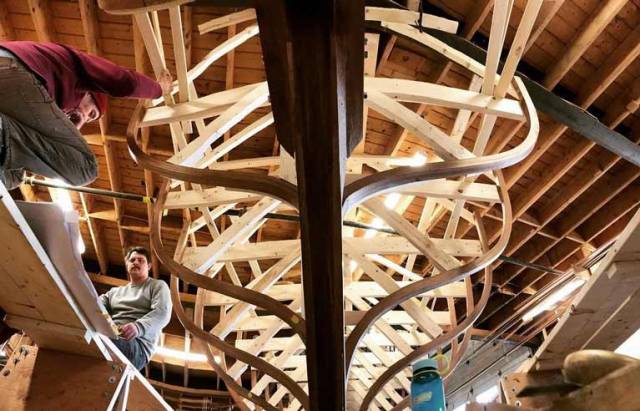Dublin Bay has an unrivalled continuous history of One-Design sailing and racing writes W M Nixon.
It runs in a golden thread all the way back to 1887, when Ben Middleton launched his little class of Water Wag dinghies to establish an ideal and a tradition which has grown and developed to be comfortably at the core of sailing not just from Dun Laoghaire itself, but on all of the coasts of the Greater Dublin area.
Over the years, different One-Design classes have lasted for varying periods of time. But there has always been the thought that once a size has proven popular, then its successor class will reflect this. Yet even with new classes arriving, boats of the older types have sometimes survived, and this has created an unexpected consequence which is now having an international spinoff.
In many maritime parts of the world, boat-building schools and academies have been springing up for all sorts of reasons, including historical meaning, sociological needs, skills training, creative challenge, hobby teaching, and the simple pleasure of working with wood – you name it, it can be found as part of the thinking behind establishing a boat-building school.
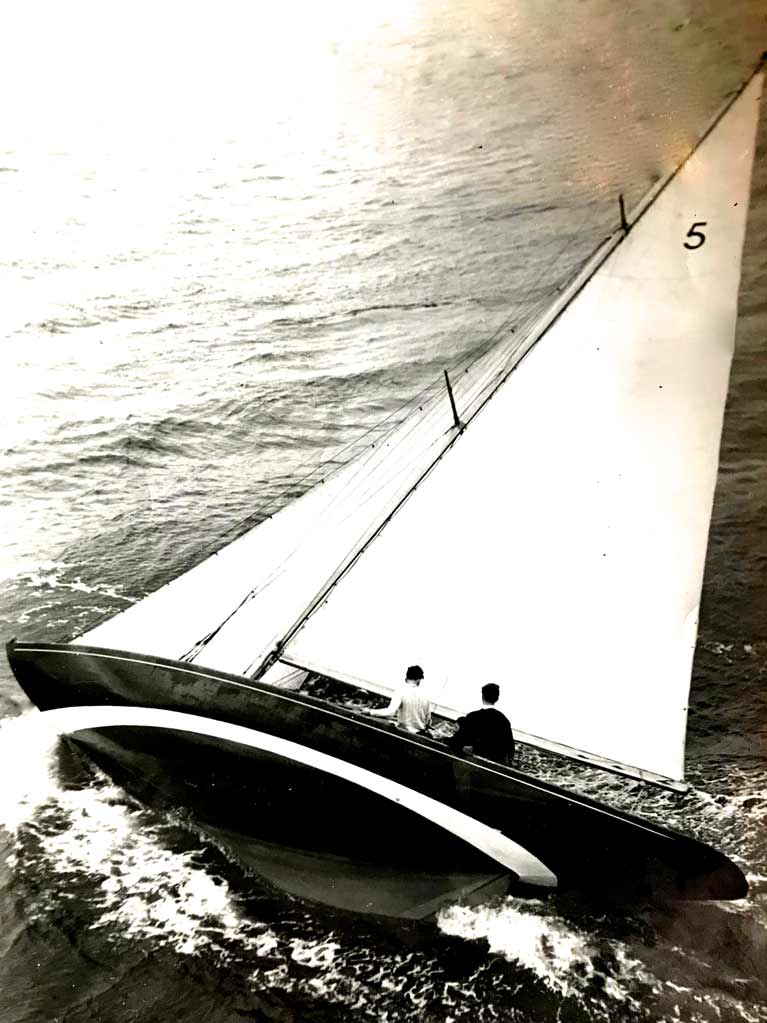 The sheer style of the Dublin Bay classics has global appeal – this is the Martin brothers having a bit of sport with Adastra in a wayward gust at the entrance to Dun Laoghaire Harbour in the 1950s. Photo courtesy Martin family
The sheer style of the Dublin Bay classics has global appeal – this is the Martin brothers having a bit of sport with Adastra in a wayward gust at the entrance to Dun Laoghaire Harbour in the 1950s. Photo courtesy Martin family
These schools have found a treasure trove in Dublin Bay’s unrivalled collection of One-Design boat plans, a selection whose creators have included such distinguished names as William Fife and Alfred Mylne, not to mention Irish designers such as Maimie Doyle and John B Kearney. Their legacy is historic wooden boats of varying size and type, each of which can be used as perfect subject matter for their pupils.
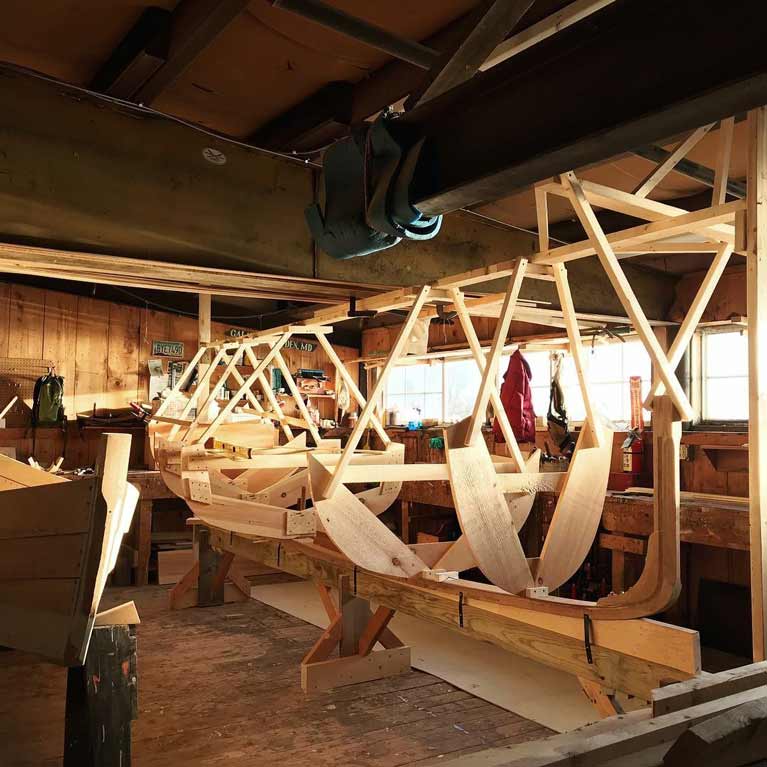 Early stages of building a Water Wag at the Apprenticeshop
Early stages of building a Water Wag at the Apprenticeshop
Thus at the moment the famous Apprenticeshop in Maine under the direction of Kevin Carney is re-building the Dublin Bay 24 Zephyra for David Espey of Dun Laoghaire – a project so total that the main part of the original boat is virtually only the ballast keel - while nearby, a completely new Water Wag (to the 1900 Maimie Doyle design) is also under construction.
Meanwhile in Brittany at Douarnenez, the remarkable Paul Robert and his team at the impressive complex which is Les Ateliers de l’Enfer have two Irish-related projects under way – a re-building of the 1900 Howth 17 Anita from the ballast keel up, and the making of sails traditional-style for the 1896 Herbert Boyd-designed 26ft Marguerite now owned by Guy Kilroy, which is currently undergoing restoration back in Ireland by Larry Archer in his very rural shed in the depths of Fingal.
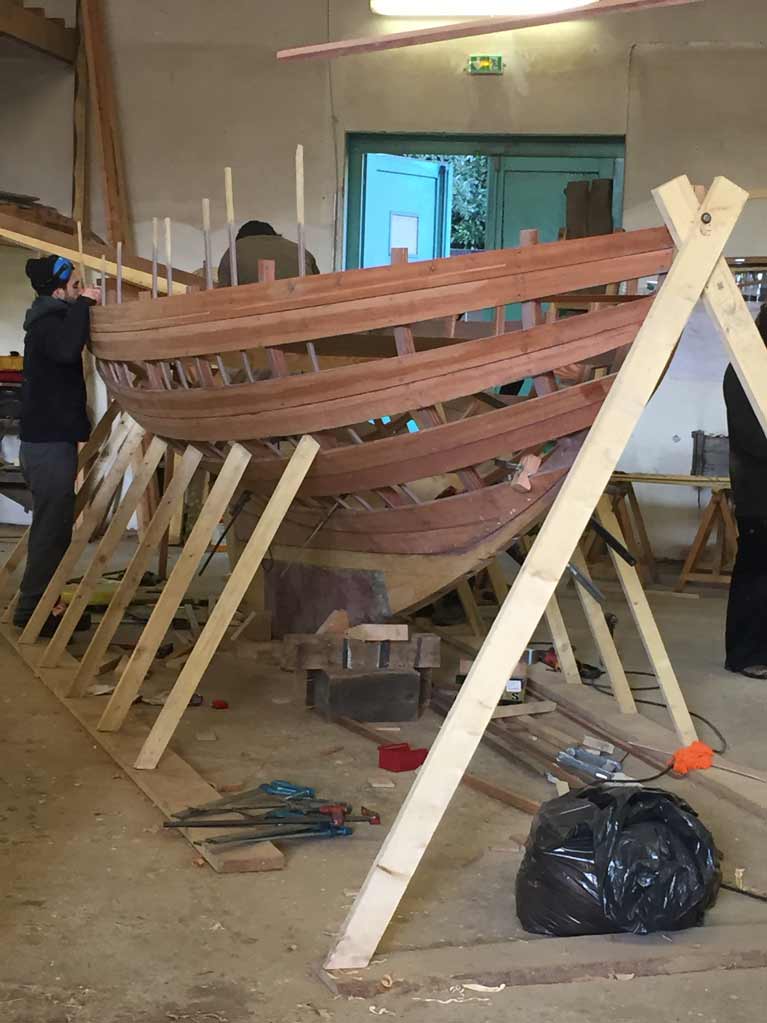 Planking under way on the re-build of the Boyd-designed Howth 17 Anita at Douarnenez in Brittany. Photo: Ian Malcolm
Planking under way on the re-build of the Boyd-designed Howth 17 Anita at Douarnenez in Brittany. Photo: Ian Malcolm
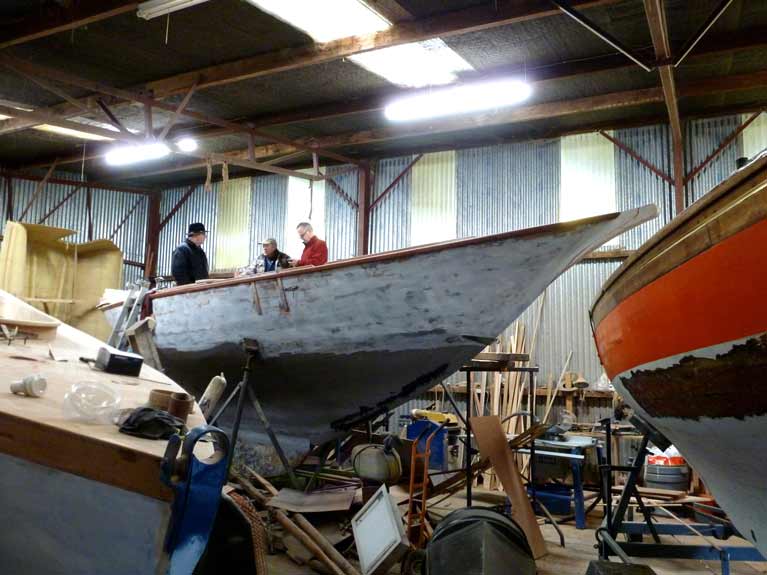 Another Boyd design, the 26ft Marguerite of 1896, is being restored for Guy Kilroy by Larry Archer in rural Fingal. Photo: W M Nixon
Another Boyd design, the 26ft Marguerite of 1896, is being restored for Guy Kilroy by Larry Archer in rural Fingal. Photo: W M Nixon
South down the Breton coast, Mike Newmeyer’s famous Skol ar Mor is busy on some French craft this winter, but in times past they’ve worked creative wonders on designs as diverse as the Dublin Bay 24 Periwinkle, the Howth 17 Orla, and Water Wags and Shannon One Designs, such that they hope to get back with one of the Irish designs next winter.
Further south again down the Biscay coast, and at San Sebastian in Spain’s Basque country, one of the most beautifully-built Water Wags ever seen – David Williams’ Dipper - emerged last year from the Abeola boat-building school under the direction of Brian McClelland. There’s another one currently under constriction for Mary Chambers, while the word is that other more distant places have been enquiring of the class about acquiring plans, and what they need to do in order for their finished product to be recognized as a true Water Wag.
And here we find another of the advantages of drawing on Dublin’s treasure trove of One-Design plans in order to launch a boat-building training exercise. For as the job progresses, today’s economical air travel means that the builder can get the class measurer to come and give the project his approval and encouragement.
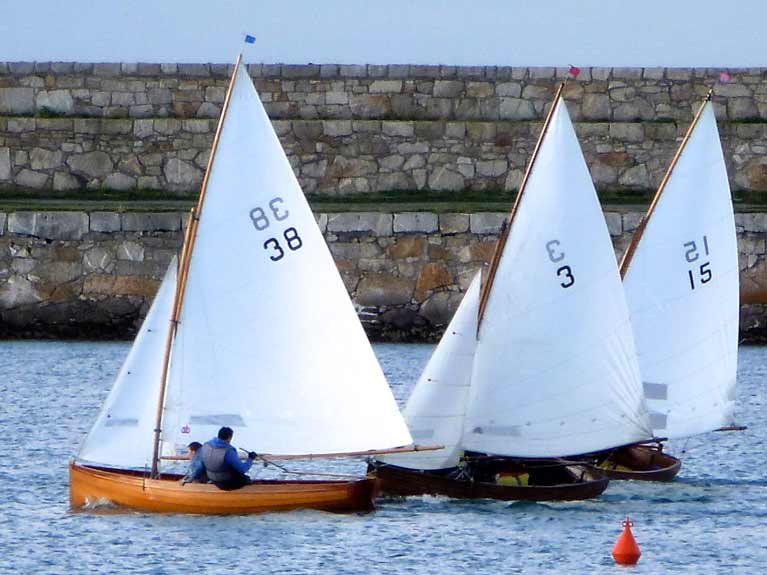 Today’s Water Wags – seen here in close contention in Dun Laoghaire Harbour – have become pace-setters in the classic boat movement in Ireland. Photo: W M Nixon
Today’s Water Wags – seen here in close contention in Dun Laoghaire Harbour – have become pace-setters in the classic boat movement in Ireland. Photo: W M Nixon
Thus the trainee boat-builders – sometimes adults as much as young people – not only learn how to work with timber and put a seaworthy boat together in classic wooden boat style, but they also learn to build with precision if they use a living Dublin Bay design.
Of course, not all contemporary re-creations of Irish wooden boats are taking place outside Ireland, and in Ireland not all such projects use Dublin designs. At Oldcourt near Baltimore, Liam Hegarty and his team – having finished their work on the restoration of the 56ft Conor O’Brien ketch Ilen of Limerick back in the Spring – are now into the re-building of O’Brien’s world-girdling 42ft Saoirse.
And just up the road at Ballydehob, Tiernan Roe is restoring the famous Lady Min, originally designed and built by Maurice O’Keeffe of Schull in 1902. Nearby, Rui Ferreira’s workshop may be best-known locally as the spiritual home of the clinker-built Ette Class from Castlehaven, but he is also completing a Water Wag for Martin Byrne of Dublin Bay to a standard which will rival the San Sebastian boat.
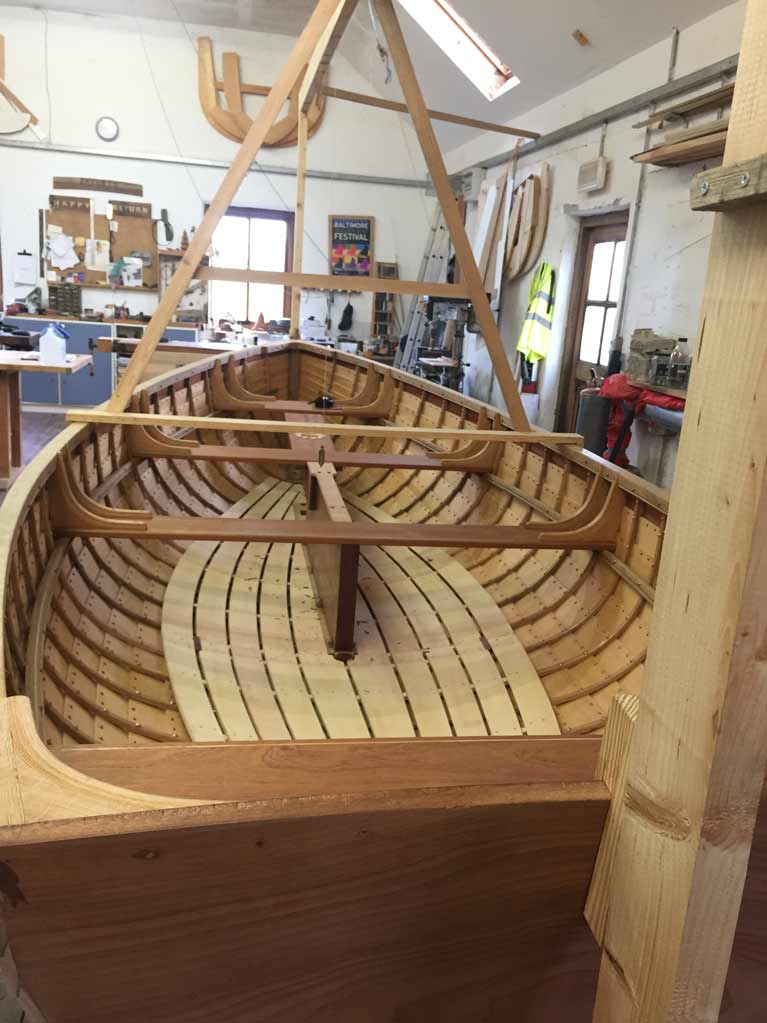 A work of art – the new Rui Ferreira-built Water Wag for Martin Byrne nears completion in Ballydehob
A work of art – the new Rui Ferreira-built Water Wag for Martin Byrne nears completion in Ballydehob
Moving northwards along the western seaboard, at Kilrush on the Shannon Estuary, Steve Morris has finished one hull of the Hal Sisk and Fionan de Barra project to re-build three of the legendary Dublin Bay 21s of 1902, and another is on the way, while across at Foynes, the thriving Mermaid class has seen new boats being built by the voluntary effort for which Foynes Yacht Club is deservedly famous.
 The Dublin Bay 21 Naneen was re-built with the hull inverted, and is seen here at Kilrush shortly after being turned. Photo: Hal Sisk
The Dublin Bay 21 Naneen was re-built with the hull inverted, and is seen here at Kilrush shortly after being turned. Photo: Hal Sisk
Further north, it’s very seldom that there isn’t at least one major re-building project underway on a Galway Hooker in Connemara or in Galway city itself, while along the Shannon, boat-building legend Jimmy Furey has – with Cathy MacAleavey’s encouragement – continued to build Shannon One Designs and Water Wags, while the same historic clinker-built classes have also benefited from the boat-building skills of Dougal MacMahon of Belmont in County Offaly, and the future should see a further combination of these three remarkable talents.
Although the Shannon One Designs may be indigenous to the great river and its lakes, the Water Wags are Dublin Bay through and through, and we find a sort of circle around their home port which has seen Jack Jones of Anglesey building Wags, while at the Elephant Boatyard on the Hamble in the heartlands of the Solent, there’s another Dublin Bay 21 coming back to life.
Thus there’s an underlying sense of ever increasing circles rotating around the re-building of classic Dublin Bay classes, initially taking in western Ireland and Fingal and Wales, then broadening to include France and Spain, and now expanding still further to include North America.
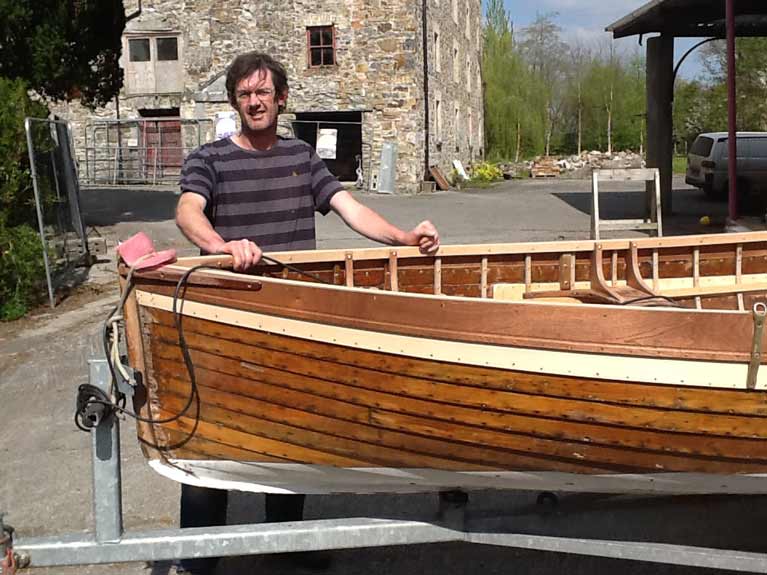 Dougal McMahon at Belmont in County Offaly with restorative joinery work on the 1915 Water Wag Barbara. Photo: Ian Malcolm
Dougal McMahon at Belmont in County Offaly with restorative joinery work on the 1915 Water Wag Barbara. Photo: Ian Malcolm
Yet at the very heart of these circles in Dublin Bay, we find a desert for classic wooden boat-building. Certainly, there was a fine new coastal skiff completed recently at St Michael’s Rowing Club in Dun Laoghaire. But nearby, the ever-busy maintenance, repair and modification facility of the Irish National Sailing School is very much a place where plastics and chemistry are dominant.
In a weird sort of way, it is generally accepted that there is no classic yacht building tradition in Dun Laoghaire – the view seems to be that it is always outsourced. Yet surely there’d be welcome extra life put into the Dun Laoghaire waterfront if – as an integral part of it – there was an active and accessible Boat-Building Academy?
It could incorporate the ideals which boat-building training gurus such as America’s Lance Lee (best known in Ireland for his links to the Bantry Boat movement) have been articulating so determinedly and successfully for decades, such that the local community and wider sociological benefits of establishments like this no longer need to be argued – rather, it’s a matter of specific location and size.
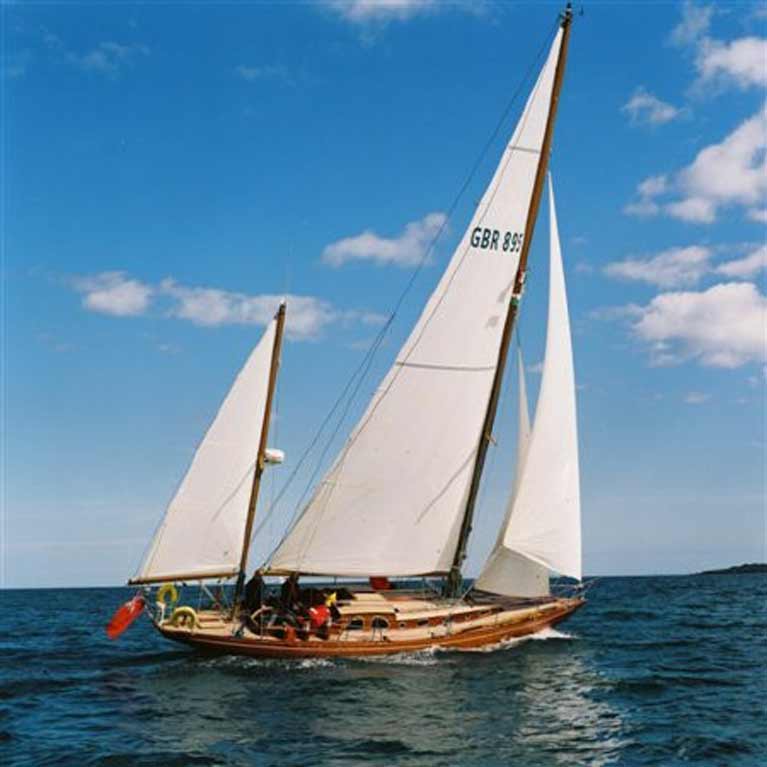 One of the last larger classics to be built on Dublin Bay, the 41ft Knud Reimers-designed Marian Maid (John Sisk) was launched in 1954, and was restored in 2002
One of the last larger classics to be built on Dublin Bay, the 41ft Knud Reimers-designed Marian Maid (John Sisk) was launched in 1954, and was restored in 2002
And as for the argument that Dun Laoghaire and its immediate area have no tradition of classic building, that’s not so. Admittedly it was all of 65 years ago that the last yacht of significant size, the 41ft yawl Marian Maid, emerged from the Dalkey Yacht Building Company for John Sisk Senr of the noted contracting firm. He owned the boatyard as a sideline, and their main trade was in building Folkboats. But in 1953 he approached the famous Swedish designer Knud Reimers for his take on the new International 8 Metre Cruiser/Racer, and the result was a design which Reimers liked so much that while John Sisk had Marian Maid built on the shores of Dublin Bay, Reimers had a sister-ship built for himself in Sweden.
Marian Maid had a restoration in northwest England in 2002, and made a ceremonial return to Dun Laoghaire to remind everyone that, once upon a time, such classics were built locally. But of course if we go back to the hyper-active days of One-Design growth and development in Dublin between 1895 and 1910, we find that there were several yards such as Doyle, Clancy and Hollwey producing work of the highest quality to create classes like the Dublin Bay 25s, the Dublin Bay 21s, the Howth SC/DBSC 17s, and of course the Water Wags.
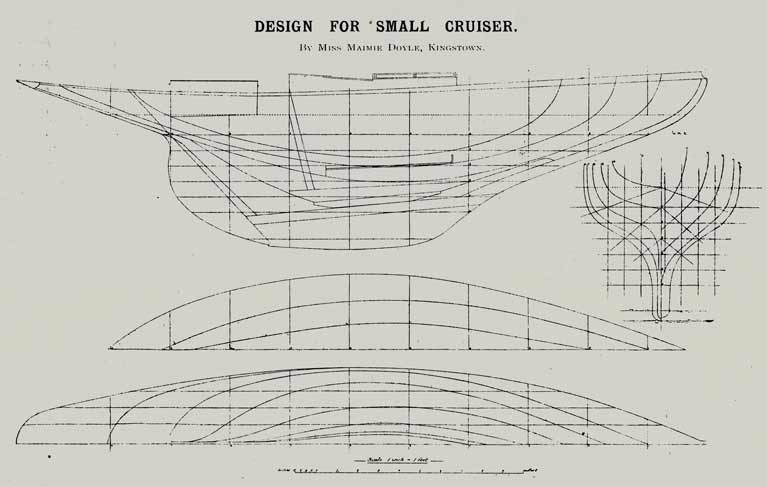 Maimie Doyle’s plans for the 1901-built 9-tonner Granuaile
Maimie Doyle’s plans for the 1901-built 9-tonner Granuaile
The Water Wags of the 1900 design were a James Doyle speciality, but equally in his Dun Laoghaire workshop he could turn out keelboats such as the Dublin Bay 25s, and in 1901 his daughter Maimie finalized the design for a 9-ton cruiser which, although named Granuaile, was based far indeed from the home waters of the Pirate Queen Granuaile on Ireland’s western seaboard, as her home port was Burnham-on-Crouch in the Thames Estuary.
The new boat was such a success that in 1905 the two owners ordered a significantly larger sister-ship, a 52ft fast cruiser also called Granuaile. She may have originally followed her predecessor to the Thames Estuary, but this larger Granuaile has had a colourful life since, and after a period in America, in 1968 she fetched up in Australia, and Limerick ex-Pat Lee Condell alerted us to the fact that she is currently Tasmania-based.
 The 52ft Granuaile of 1905, designed and built by Doyle of Kingstown. Constructed of teak planking on teak frames, she is currently based in Tasmania.
The 52ft Granuaile of 1905, designed and built by Doyle of Kingstown. Constructed of teak planking on teak frames, she is currently based in Tasmania.
So the largest yacht built by the legendary James Doyle of Dun Laoghaire is still very much with us after 115 years, partly attributable to the fact that she was built of teak planking on teak frames, which even in the high-spending days of 1905, wasn’t exactly an everyday specification.
So if some determined group sought to set up a boat-building academy on the Dun Laoghaire waterfront, it would be the revival of a time-honoured tradition rather than the introduction of something totally novel. And certainly several people over the years have promoted the idea, but the obstacles have always proven too great, and inevitably you’ll ultimately come up against the realities of the frenetic Dublin property market.
For if a useful and attractive waterside location could be identified for such a project, as sure as God made little apples someone will see that it would be much more profitable as a residential development. And so we who find classic boats irresistible are left with the fact that, while great Dublin Bay boat designs are being built at locations in ever-increasing circles which now cross oceans, right at the centre of the circle in Dun Laoghaire, there’s a boat-building void as far as the Harbour’s classics are concerned.




























